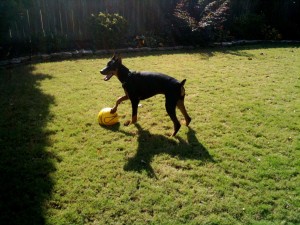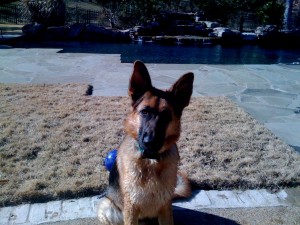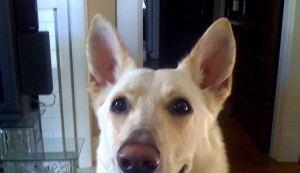 Resource guarding is when dogs posture, growl, snarl, bark, snap, lunge, or bite for reasons we believe are efforts to keep other animals or people away from what they consider to be valuable resources.
Resource guarding is when dogs posture, growl, snarl, bark, snap, lunge, or bite for reasons we believe are efforts to keep other animals or people away from what they consider to be valuable resources.
Resources include food, territory, items and persons.
Food related aggression, territory aggression, and possession aggression are specific labels for different types of resource guarding.
Resource guarding can be confused with protection aggression and fear aggression. People believe their dogs are protecting them, when in reality, the dogs are guarding what they believe to be their property, or the dogs are exhibiting fear aggression. Fear aggression is often present with territory aggression. Resolving the fear issue is the solution. A behavioral history, questionnaire, careful observation, and testing can usually identify the specific types of aggression.
In my experiences, resource guarding is commonly directed at other dogs, which many people accept or manage. When the aggression is directed at people, I am likely to get a new client.
Food related aggression is seen more often when high value rawhides, bullie sticks, pigs ears, etc. are involved.
Some dogs guard dry dog food (less common), and severe cases involve dogs that guard empty bowls, and feeding or food preparation locations.
Territory aggression is when dogs posture, growl, snarl, bark, snap, lunge, or bite when animals or people approach specific areas. Clearly defined areas, such as fenced yards, motor vehicles, homes, crates, kennels, rooms, chairs, couches, beds, and areas underneath furniture are guarded by dogs who exhibit territory aggression.
Less defined territories, such as doorways, and the areas within the length of the dog’s leash or tie out can be considered valuable by some dogs.
Possesive aggression is when dogs guard non-food items, regardless of the location. Common items are toys, and stolen treasures, such as socks paper towels, ink pens, remote controls, etc.. Some cases of posessive aggression can be resolved by teaching the dog basic obedience commands such as leave-it and drop.
Some aggression behaviors can be fueled by miscommunications and the balance between dogs and people, better described as the relationship. In some cases, the dog’s physical, social, or emotional needs are not being met, and / or, the chosen training methods are flawed. A 21st Century Canine Relationship Specialist can help you with these areas. Visit the APDT to find a trainer near you.
Regardless of the type of aggression, the first step is to manage the environment so the dog does not practice (and people or other animals are not injured). Prevention can include simple steps like removing high value food items, feeding in a crate or secure area, crating the dog during social events, removing toys, housing the dog inside the home, and dog proofing the home.
Next, you’ll need to establish a clear system for communication and motivation. Condition a reward marker and follow the rewards awareness program, no free F.A.T.!
There are specific exercises for treating different types of resource guarding. Each dog and case is different. The treatment plan must be fluid and should be adapted for the dog’s success. You’ll probably need help from a dog behavior counselor.
Visit this Solve-It section on this site for specific examples and detailed solutions for aggression.
Happy Training!
Alan J Turner – Companion Animal Behavior Counselor and Trainer, Canine Specialization
How’s Bentley – Memphis, Collierville, Germantown TN
21st Century Canine Relationship Solutions
Private Dog Training in Memphis TN
Reactive Dog Specialist


